
by Clay Farris Naff Thursday, January 5, 2012
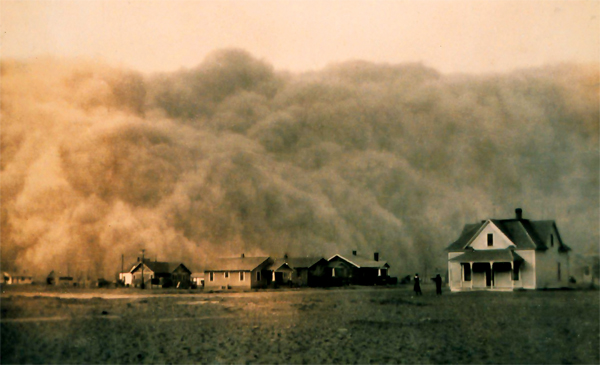
Dust storm approaching Stratford, Texas, in 1935 during the Dust Bowl years. NOAA George E. Marsh Album
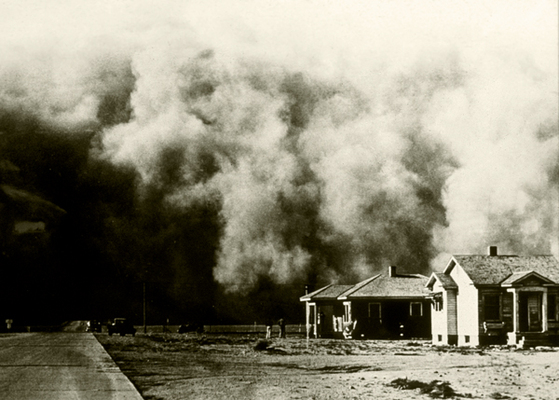
A 'great roller' moves across Colorado during the Dust Bowl. NRCS
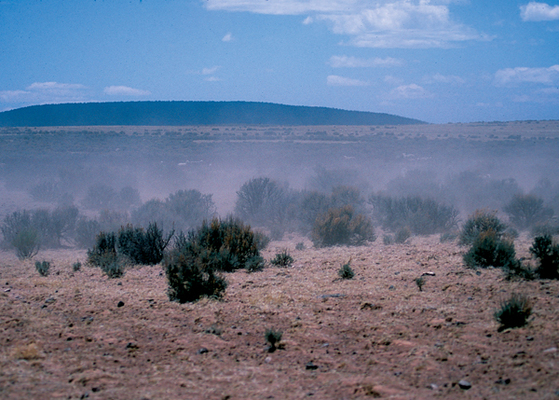
Wind erosion on rangeland in Rio Arriba County, N.M. Jeff Vanuga, NRCS
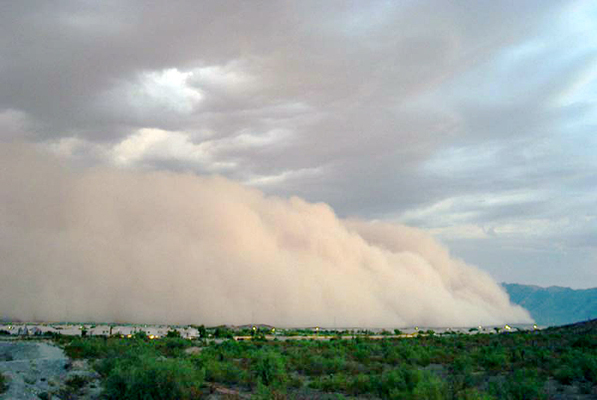
Three haboobs - similar to this one from 2003 - struck Arizona last summer. Junebug172
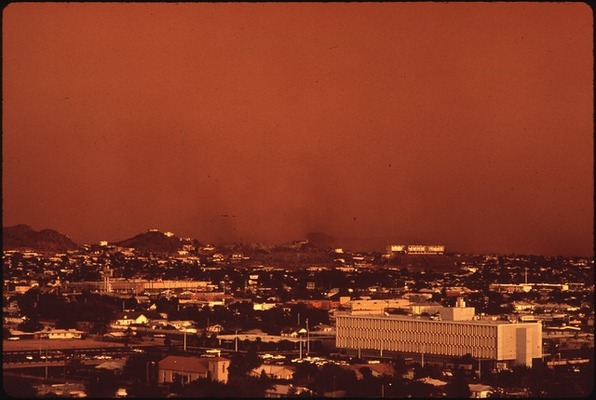
After 153 straight days of no rain in 1972, dust storms enveloped Phoenix, Ariz. U.S. NARA
Haboobs walloped Arizona last summer. Locals long ago adopted the Arabic word for a major dust storm, but even old-timers say they can’t remember anything quite like this year’s aerial assaults.
One that struck Tucson in July reportedly towered more than 1.6 kilometers in the air, had a 160-kilometer breadth and featured scouring winds of up to 112 kilometers an hour. Phoenix was hit three times, including a haboob in July that topped out at about 1.2 kilometers and stretched 80 kilometers. The massive dust storms knocked out power, grounded flights, caused car accidents and, perhaps most significantly, gave us a glimpse of the potential future of the American West.
Researchers from a variety of disciplines concur on this forecast: Over the next two or three decades, the American West — from West Texas to New Mexico, Arizona, Colorado and on into Southern California, Nevada and Utah — will transition to a climate that may make the 1930s Dust Bowl seem mild and brief.
The grim forecast is no simple extrapolation from climate models. Rising temperatures will contribute directly and indirectly to rising dust, but that is only one of many converging causes, both natural and human. Persistent drought, increasingly violent and variable weather, urban and suburban development, off-road recreational vehicles, and even the installation of large-scale solar energy arrays threaten to shroud the West in dust.
The rise in dust, which includes any solid particle small enough to become an aerosol, can’t be ignored. As last summer’s haboobs demonstrated, great volumes of dust can wreak havoc. Worse yet, the composition of today’s dust — which includes industrial pollutants from as far away as China, heavy metals such as mercury and lead, potentially deadly soot from wildfires and a local pestilence known as Valley Fever — poses a threat to public health.
To understand why the West is headed for a Dust Bowl future, scientists first need to understand dust itself. Dust has always been part of our environment, explains Jason Neff, a geochemist at the University of Colorado at Boulder. It performs valuable ecosystem chores, such as transporting minerals from barren deserts to the oceans, where they support life.
Most of the dust in the West formed through erosion over millions of years in places like the Mojave and Sonoran deserts, and it remained grounded most of the time — until people, with their herds, homes and machines, came along and kicked it up into the atmosphere. Neff says that he and a small band of scholars who study dust had no idea how much influence humans have on the dust “flux” — the volume lofted into the air — until the mid-2000s, when they studied lake sediments in Colorado’s San Juan Mountains, far from any grazing or mining. Through analysis of the sediment composition, they measured the amount of the dust trapped in each annual layer.
What they found was astonishing. From the 1860s to the early 1900s, the dust load of the atmosphere shot up 500 percent. The main reason for the upsurge was cattle. During that period, railcars transported more than 50 million head of cattle to graze out West, Neff says. “Overall, nearly 70 percent of the natural ecosystems of the Western United States have been affected by livestock grazing,” which has resulted in the loss of soil stability and increases in wind erosion of soil, Neff and his colleagues reported in Nature Geoscience in 2008. That, in turn, released great volumes of dust into the atmosphere.
Eventually, the dust settled down again with the passage of the 1934 Taylor Grazing Act, which set restrictions on the use of public lands for grazing, followed by a switch from free-ranging cattle to feedlots. But many experts think the dust flux may be headed for another spike, likely due to a combination of natural and human factors.
Left to its own devices, nature is surprisingly stingy about letting dust escape into the atmosphere. Vegetation holds down dust in many places, but even where the soil is too dry to support year-round vegetation, biological crusts do the job. During wet seasons, cyanobacteria, algae and other microorganisms flourish in the surface moisture. In dry seasons, they form a crust up to 10 centimeters deep, sealing in the dust. Such crusts can be found even in the heat of the Mojave and Sonoran deserts.
Dust is also stashed under the pebbles and rocks commonly found in alluvial fans in the valley and ridge landscapes. Such water-wrought geological features appear even in the most arid places, such as Death Valley National Park in California. Rains wash dust under the rocks, where natural sorting ends up packing the tiniest grains underneath the largest, says Gregory Okin, a geochemist at UCLA who specializes in the study of dust. “It’s like when you go to the movies and get a box of popcorn,” he says. “You find the big, puffy kernels at the top, and all the little broken pieces at the bottom.” In some places, he says, as much as three meters of dust is trapped beneath a natural pavement of alluvial rocks and pebbles.
All that changes, however, when humans move in. Neff and his colleagues have gone into remote areas of Utah and Colorado to compare sites that have never been grazed by cattle and those that have been lightly grazed. Even a minor intrusion by cattle, they found, can lead to substantial erosion. In a 2005 paper in Ecological Applications, Neff and his colleagues reported that areas that had been intermittently grazed and then left untouched for 30 years had less than half the silt content of soil in a comparable but pristine area. Where cattle had grazed, the fine particles had long since blown away.
As much as cattle play a role in the creation of dust, grazing is now dwarfed by the gigantic footprint of development. The oil and gas industry has been booming again, along with renewable energy sources and suburban and urban development. It doesn’t take much, experts say, for intrusion into a fragile environment to release dust. Even a “green” energy industry such as solar power can do damage when builders site large-scale solar arrays in pristine desert, Okin says. Transportation associated with this development is also a major part of the problem.
“Biologically crusted soils and alluvial fans are bulletproof in the face of wind,” Okin says. “But if you drive a truck over them just once, you take away all that protection.” Recreational off-road vehicles are just as bad, he adds. “You can get a huge amount of dust flowing from a single track.”
Direct human action on land cover is just one reason why dust is likely to increase. Climate change is another. As temperatures rise, persistent future drought in the West seems far more likely — and that means more dust. Drought strips away moisture that might hold down dust, kills off protective vegetation, and opens cracks in the ground that can furnish additional dust to the hot, dry winds. Prolonged drought can even kill off the biological crusts, Neff says.
In the future, a drought like the record-breaking one that has gripped Texas and much of the Southwest this year could stick around for decades, says Laurence Smith, a geographer at UCLA. “We could see drought persisting for 50 to 70 years,” he says. “It’s happened before. Tree ring records show plenty of droughts of that length.”
Climatologist Brian Fuchs of the National Drought Mitigation Center in Nebraska agrees that the region could be in for a historic dry spell. “The geography of the West lends itself to a multiyear drought. It’s semi-arid to begin with, and any little hiccup can stress the system.” He hastens to add, however, that no one knows whether such a drought has begun.
Underlying the uncertainty is the Pacific Decadal Oscillation, or PDO. This hot-and-cold oscillation in the sea-surface temperatures of the world’s largest ocean was only identified some 15 years ago, and its complex interaction with the more familiar El Niño-La Niña cycle is far from wholly understood.
The PDO rocks back and forth on a cycle of anywhere from 20 to 50 years, sometimes amplifying the extra rainfall that El Niño brings to the Southwest and sometimes diminishing it. Research indicates the PDO and its Atlantic Ocean counterpart (the North Atlantic Oscillation) could account for more than half of the variance in long-term droughts on the continental United States.
As it happens, thanks to a favorable PDO, most of the 20th century was anomalously wet in the West, Smith says. It is ironic, he notes, that the 1922 Colorado River Compact was framed during a time of relative plenty to deal with what even then was seen as a limited supply of water. Now, however, the PDO seems to have flipped. A 2003 study by Taro Takahashi of Columbia University and colleagues in Science indicates that it underwent a phase change in about 1990. Instead of amplifying precipitation, the PDO now seems to be suppressing it and amplifying droughts in the western half of the United States.
Scientists just don’t know enough about the complex interactions of the PDO, El Niño and other climatic influences to be sure that precipitation levels will remain suppressed. After all, last winter brought exceptional snowfall to the Rockies, Sierra Nevada and Cascades, and spring rains led to massive flooding in the Midwest. But Smith says he has an uneasy hunch. “Notwithstanding this past year,” he says, “California has been in persistent drought for eight or nine years.”
Models support that hunch on other grounds. Rainfall is notoriously difficult to model, due to the chaotic nature of precipitation. But regardless of rainfall, studies show that the rise in average global temperatures alone will lead to drier conditions.
Aiguo Dai, a climate scientist at the National Center for Atmospheric Research (NCAR) in Boulder, Colo., agrees. In a study in Wiley Interdisciplinary Reviews last year, Dai and his colleagues examined the precipitation outlooks projected by 22 climate models and found that regardless of how they diverged in forecasting precipitation, most converged on an ominous trend: a bone-dry future for the West. No matter how much rain or snow the models foresee, evaporation and transpiration due to higher temperatures will prevent the environment from trapping moisture, the researchers say.
“In the next 30 years,” Dai says, “a very dire situation will develop. Much of the Western U.S. will be in constant severe or extreme drought.”
Dai and his colleagues quantified the drought conditions with what is known as the Palmer Drought Severity Index. On the index, zero is considered normal; anything below minus 3 is considered a severe or extreme drought. Dai’s analysis of the computer models shows that as average temperatures climb 1 to 2 degrees Celsius above the historical mean over the next couple of decades, the West will experience persistent heatwaves, causing the drought index to reach a minus 3 by 2030. As temperatures continue to climb, the index will fall into a range of minus 4 to minus 6. Conditions will continue to worsen until 2060, Dai predicts, at which time they will stabilize in a steady state of severe drought at minus 6 or worse.
A drought of that length raises the specter of the 1930s Dust Bowl, in which more than 20 million hectares of farmland lost soil to airborne dust. Improved irrigation, reservoirs and groundwater can stave off disaster for about five years, Smith says. But the Colorado and other rivers are overdrawn, the major reservoirs of the West have been dropping, and, he warns, the regional aquifers are nearing depletion.
Arizona is in real trouble, he says. So too are the cotton fields of the Texas panhandle. “They’re done. They are going to revert to dust.”
Drier conditions can add to the dust flux in another way. A longer dry season leads to more wildfires. The number of wildfires in the West increased by 500 percent and the area burned increased almost 760 percent since the early 1980s, reported Anthony Westerling, an assistant professor of environmental sciences at the University of California at Merced, and his colleagues in Science in 2006. During the 2000s, the area lost annually in the United States to wildfires averaged 2.8 million hectares, nearly 10 times the area of Yosemite National Park, according to NOAA. Most of those lands were in the West.
What do wildfires have to do with dust? Atmospheric scientist Christine Wiedinmyer of NCAR, an expert on the emissions of forest fires, points out that they are loaded with fine particles of black carbon — a kind of dust that can infiltrate human lungs and cause great harm. Moreover, she notes, wildfires contribute directly to the climate change that boosts dust flux. “In some states in the region, such as Idaho, more carbon dioxide comes from forest fires than human sources,” Wiedinmyer says.
Life in an increasingly dusty environment will be unpleasant, but it may also be downright unhealthy. According to the Centers for Disease Control and Prevention, airborne dust was first recognized as a trigger for asthma 300 years ago. Because of that link, doctors once hailed the Southwest as a haven for asthma patients because of its dry air and lack of airborne pollutants. But now, concerns over dust storms have become so acute that NASA dedicates satellite time to try to alert public health officials about impending dust storms so they can warn asthma patients and others with respiratory ailments.
But dust isn’t only a worry for those with respiratory ailments. The human body is fairly adept at coping with ordinary specks of dust. But if the dust particles are fine enough, like the soot from wildfires, they can slip by the nasal hairs, mucus and other bodily defenses and embed themselves deep inside the lungs, where studies show they can cause problems ranging from inflammation to cancer. The dust becomes even more dangerous when heavy metals and industrial pollutants are added to the mix.
Worse yet, diseases latch onto dust. Valley fever is a fungal lung infection endemic to the Southwest, especially Arizona. Geographer Peter S. Johnson of the University of Arizona says that up to half the residents of California’s San Joaquin Valley (which gave the infection its name) and areas of New Mexico and Arizona have been infected with the disease at one time or another. The incidence typically rises following a dust storm, as the fungal spores ride the winds right into the lungs of unlucky residents. Most victims suffer nothing worse than flu-like symptoms, but the disease has about a 1 percent mortality rate.
On the other hand, dust may have some advantages in the health arena. The prevalence of hantavirus — a potentially fatal flu-like illness that is contracted by breathing in dust contaminated with the urine, saliva or feces of infected deer mice — may diminish. That’s because the deer mice, the main vector for the virus, will likely find it tougher to survive in a drier, hotter and dustier climate, according to epidemiologist Gregory Glass of Johns Hopkins University.
Other transmissible diseases, such as Dengue fever, could also decrease as the environment becomes more hostile to their vectors, principally mosquitoes and fleas. However, Glass says, if people continue to try to maintain golf courses, green lawns and other artificially wet environments in the middle of an increasingly dry and dusty landscape, they may create islands of refuge for the pests that carry these diseases.
“Changing the microclimate allows species that wouldn’t survive the changing climate to persist around people,” he says. With virus-bearing vectors, he adds, “that’s not something you’d want to do.”
Climatologists admit to uncertainties in their models, particularly in long-term forecasts of precipitation. Fuchs, of the National Drought Mitigation Center, says there is a 50-50 chance that the drought currently gripping Texas will go on for years. Or, just as likely, that it will end with the tropical storm season. “We don’t know,” he says. “We just don’t have the forecasting technology to know that.”
So it is possible that the West will not be as dry as the models suggest. Volcanic eruptions, an unforeseen turn in the PDO, or some other factor might change the climate trajectory for the West. But in view of all the factors contributing to the rising dust flux, experts in that area feel more certain of their predictions.
“If it were getting wetter and cooler,” Okin says, “if the rains were less variable, if there were less growth in the Southwest, fewer fires, less off-road-vehicle traffic, fewer large photovoltaic installations — if all those things happened, then maybe [the West wouldn’t become a dust bowl]. But none of those things is expected to happen.”
Considering how all these factors are piling up, Okin says, “I see no reason why it won’t occur.”
© 2008-2021. All rights reserved. Any copying, redistribution or retransmission of any of the contents of this service without the expressed written permission of the American Geosciences Institute is expressly prohibited. Click here for all copyright requests.